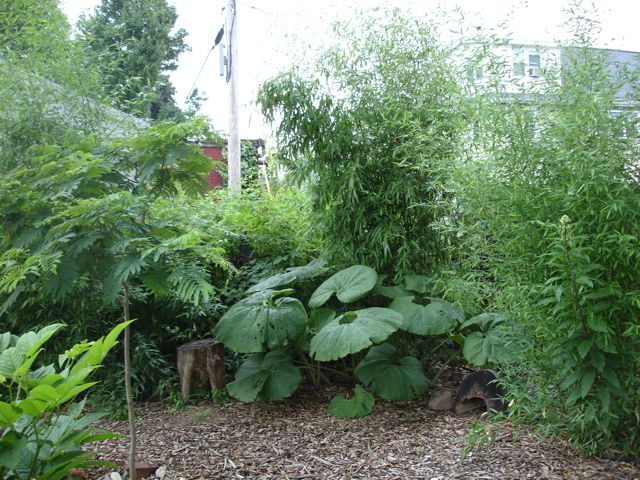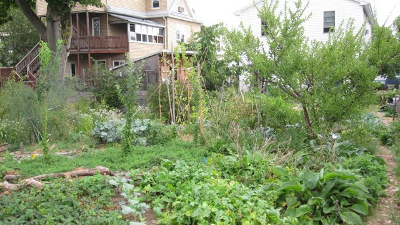
Nitrogen fixation in the forest garden
 Toensmeier didn't only report
on his own forest garden in Paradise Lot; he also included tidbits
he'd seen in others' gardens around the world. In his experience,
forest gardeners tend to follow one of three main methods of
incorporating nitrogen-fixing plants into forest gardens.
Toensmeier didn't only report
on his own forest garden in Paradise Lot; he also included tidbits
he'd seen in others' gardens around the world. In his experience,
forest gardeners tend to follow one of three main methods of
incorporating nitrogen-fixing plants into forest gardens.
The first method is
typified by Martin
Crawford's forest garden in England. Crawford includes a
tall, open canopy of nitrogen-fixing plants, which in his case is
primarily high-pruned alders. Toensmeier mimicked this technique
on a small scale by using a mimosa tree as a nitrogen-fixing canopy
species, but he wasn't very interested in using up much of his small
backyard with nitrogen-fixing trees.
Another method that
works well in extensive forest gardens is to alternate nitrogen-fixing
trees with food-producing trees. In general, Toensmeier wrote,
gardeners tend to alternate two or three edibles with one
nitrogen-fixer. Of course, space constraints again make this
approach problematic for the urban gardener.
 The final technique, which is
what Toensmeier mostly follows, is to use Geoff Lawton's chop-and-drop
method of coppicing nitrogen-fixing trees and shrubs. Toensmeier
also includes a lot of nitrogen-fixers in the groundcover category,
notably hog peanut, licorice milk vetch, and groundnut, although these
vigorous plants do outcompete some preferred species.
Foot-tolerant groundcovers like clovers and prostrate birdsfoot trefoil
in the pathways can also help bring nitrogen into the system.
The final technique, which is
what Toensmeier mostly follows, is to use Geoff Lawton's chop-and-drop
method of coppicing nitrogen-fixing trees and shrubs. Toensmeier
also includes a lot of nitrogen-fixers in the groundcover category,
notably hog peanut, licorice milk vetch, and groundnut, although these
vigorous plants do outcompete some preferred species.
Foot-tolerant groundcovers like clovers and prostrate birdsfoot trefoil
in the pathways can also help bring nitrogen into the system.
I'm less of a
nitrogen-cycling purist than many permaculture advocates, and I have to
admit that if I had a only a tenth of an acre, I'd devote the whole
acreage to edibles and bring in my nitrogen as manure or compost.
Even Toensmeier admits at the end of his book that the forest-gardening
dream of a do-nothing paradise is unrealistic, and if you're going to
have to nurture the garden anyway, why not topdress a little manure
from your rabbit hutch or chicken coop?
| This post is part of our Paradise Lot lunchtime series.
Read all of the entries: |
Want more in-depth information? Browse through our books.
Or explore more posts by date or by subject.
About us: Anna Hess and Mark Hamilton spent over a decade living self-sufficiently in the mountains of Virginia before moving north to start over from scratch in the foothills of Ohio. They've experimented with permaculture, no-till gardening, trailersteading, home-based microbusinesses and much more, writing about their adventures in both blogs and books.
Want to be notified when new comments are posted on this page? Click on the RSS button after you add a comment to subscribe to the comment feed, or simply check the box beside "email replies to me" while writing your comment.

or just let a few roam freely! Like a permie guy does here in hawaii. He has boxes close to his open patio for the chickens to lay eggs in and he opens the boxes from inside his house next to kitchen. meanwhile the ground cover is planted in perenial peanut and the chickens run free.
As I was reading, I was mentally preparing to add a comment about keeping meat rabbits and using their manure as a nitrogen source. Then I got to your last sentence :-).
If you're growing lots of biomass (coppicing fodder trees, rye/vetch/oats, corn, bamboo, banna grass, sugar cane, vegetable prunings, etc) you'd have a lot to give to the rabbits, cutting down on their feed costs. It's also much faster to cycle biomass through an animal than to compost it. Lastly, rabbit manure is a perfect fertiliser - it comes right out already pelletised, and it's "cool" so can go straight into garden beds (unlike "hot" manures like chicken or cow).